The year 1971 was a turbulent time on college campuses all across America. Newscasts were full of antiwar protests, civil-rights marches, and sit-ins with loudspeakers blaring the words of Bob Dylan’s eclectic poetry and the songs of screamin’, whiskey-voiced Janis Joplin. As a student at a small college in South Dakota, I desperately needed a challenge—a major change, something radical and outlandish. I longed to upset the whole program, question authority, move to a foreign country, and exchange this reality for a new set of faces, a new location, a new language.
With more daring than common sense, I began the search for an adventure. Amsterdam or Copenhagen? Kathmandu or Timbuktu? Oslo? Oslo. For this disgruntled college student, the fjords and mountains of Norway seemed irresistible. I had Norwegian ancestors and knew a handful of words and some basic phrases. The countryside rivaled the Swiss Alps and university was tuition-free. An excellent choice!
With a backpack, an overstuffed duffle bag, and soaring expectations, I began a year of university life at 60° north. Autumn brought cold mountain winds and winter brought on darkness. The Norwegian language became an obsession. I spent hours walking the cobblestone streets of Oslo, immersed in the living language and culture. On many a winter day I found inspiration in the wooden ships in the harbor, their decks blanketed with snow, their rigging whistling in the darkness.
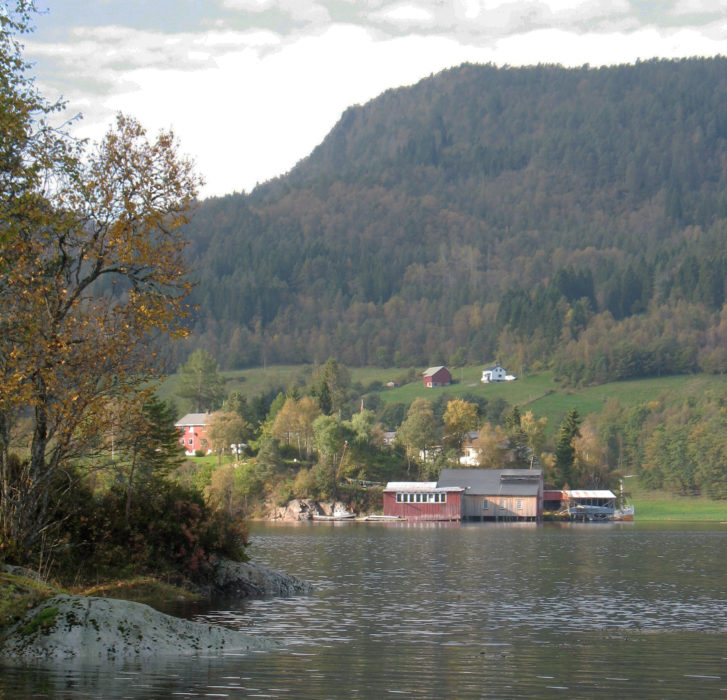 Susan Wood
Susan WoodA serene and idyllic setting, Ulset Båtbyggeri lies below Vettafjell along the shore of Kari Havet on the island of Aspøya in western Norway.
Norway is a land of forests—a valuable natural resource for millennia. The oak, beech, and Scots pine were valuable trade goods on the European continent and the British Isles. Norway furnished planking for East Indian spice traders, masts for the British navy, and even ready–to-assemble boat kits for the treeless Hebrides islanders. In Norway, the forests provided the raw material for talented craftsmen. From their ornately carved medieval log farmhouses and barns, to their brilliantly engineered and decorated stave churches, Norwegians were masters of woodworking even before the time of the Vikings. Of all the rich history and long traditions in this land, the wooden boats and ships have long stood alone as masterworks of function and beauty.
Over the course of that winter I returned again and again to the Viking Ship Museum to see the elegant 9th-century longships: Oseberg and Gokstad. These are two of the finest examples of their type that have ever been unearthed, and the artistry of those shipwrights from 1,200 years ago would profoundly influence my life’s vocation in the years to come.
At the close of one academic year at the University of Oslo, I traveled north and west into the fjord country and the home of my ancestors, and there found a vibrant, ongoing tradition of woodcarving, folk music, and boatbuilding. This “homecoming” led to many rich relationships that have grown into deep and lasting friendships. The Norwegian Viking ships and stave churches had fostered my insatiable desire to build by hand, and even after I had earned a bachelor of arts degree in Philosophy and English back in South Dakota, I longed to create tangible, functional objects with wood.
My chance came when a close friend in Upstate New York invited me to join him in building a log cabin with 88 white oak trees, axes, drawknives, augers, and a team of mules. Over the course of this work, I became a woodworker drawn to simple tools and the efficient use of materials. I was ready to get back to the elegant small boats of the fjords in Norway.
My third cousin, Martinus Kleivset, was a Norwegian boatbuilder who could offer assistance in finding a master in need of an apprentice. Building on his father’s knowledge and reputation and many builders before him, he had developed a respectable shipyard on Skålvikfjord. Just up the hill from the fjord and shipyard lay the farmhouse where my great-great-grandfather’s portrait still hangs in the parlor.
Martinus was a man of dry wit but not one to be trifled with. He put me to work scraping and painting his house (a test of endurance, I’m sure) and after several weeks, he announced that we would cross the Halsa fjord to the island of Aspøya to visit Nils Ulset at Ulset Båtbyggeri.
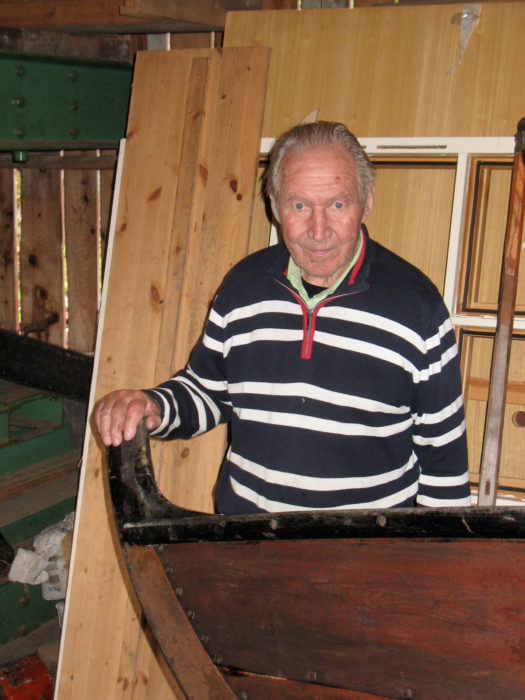 Susan Wood
Susan WoodNils O. Ulset reminisces over building the first geitbåt with Jay Smith at Aspøya in those early years.
As a young foreigner with only an urban introduction to the Norwegian language, I had little idea what was being discussed when I was introduced to Nils. His dialect is one I am still working on mastering. However, it was agreed I could begin work, with the understanding that there was no English spoken in this shop. So in August of 1977, I began building traditional lapstrake boats at Ulset Båtbyggeri on Aspøya. My feet were planted on the path I had hoped to find.
The boatworks at Aspøya is just off the narrow road that circles the island. Built on pilings at the edge of the fjord, it is nestled at the base the island’s highest peak and overlooks an inlet flanked by farms and steep hayfields. Walking the lane that meanders its way down to the boatworks, I could easily imagine the setting several hundred years earlier when small lapstrake faerings were the only transport and a necessity for survival in these coastal communities. Thousands of faerings were built each year by scores of builders, often in one- or two-man shops that dotted the coast from Oslo to the Lofoten Islands. Here I stepped into just such a shop, entering by a loading ramp to the second floor, and that unmistakable smell of Scots-pine pitch filled the air. Wood shavings covered every inch of the floor; sawdust covered every other surface except the polished handrail leading down a steep set of stairs to the floor below. There, an old faering rested with oars alongside.
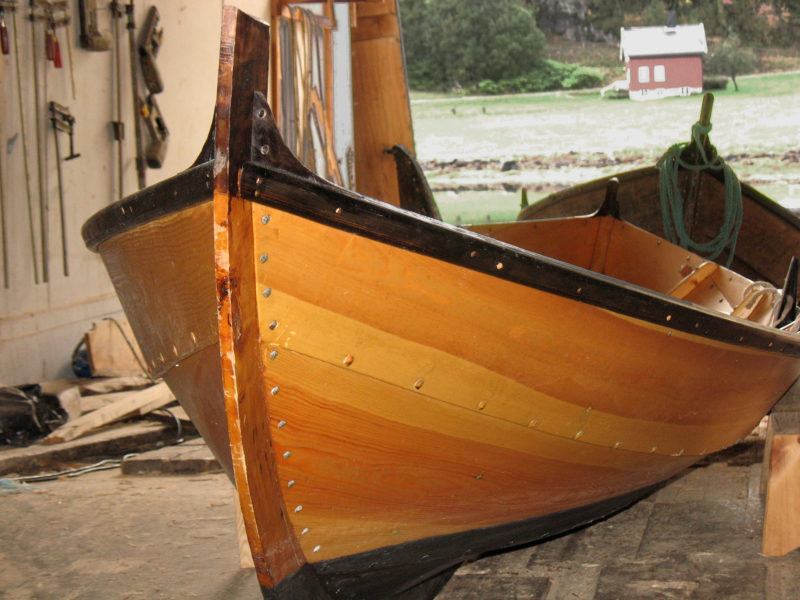 Susan Wood
Susan WoodAnother newly completed geitbåt, with bright finish and pine-tarred rails, awaits delivery at the boatworks on Aspøya in the district of Nordmøre.
The stock designs in this shop were 24′, 26′, and 28′ lapstrake double-enders with inboard diesels. There were two on the main floor, planked and framed, and there was another on the railways. Among the six of us—four boatbuilders, a joiner, and the master—there was very little discussion about the work and even less chatter regarding other matters. I was introduced to each of the workers on the first day and worked many weeks alongside them before actually having a conversation. They came to work, put in a hard day, and went home to their families.
Eventually, Nils and his sons became my close friends. Nils, one of the kindest men I have known, grew comfortable building in wood as a boy and assisted in his father’s cabinet and furniture shop, but he had always been drawn to boatbuilding. In his early teens he had built a few prams in the local Nordmøre style, but after World War II he set up a workshop and designed the larger powerboats that were quickly gaining in popularity. Ulset Boats became widely known for their fair lines, fine proportions, brightly finished planking, and mahogany cabins.
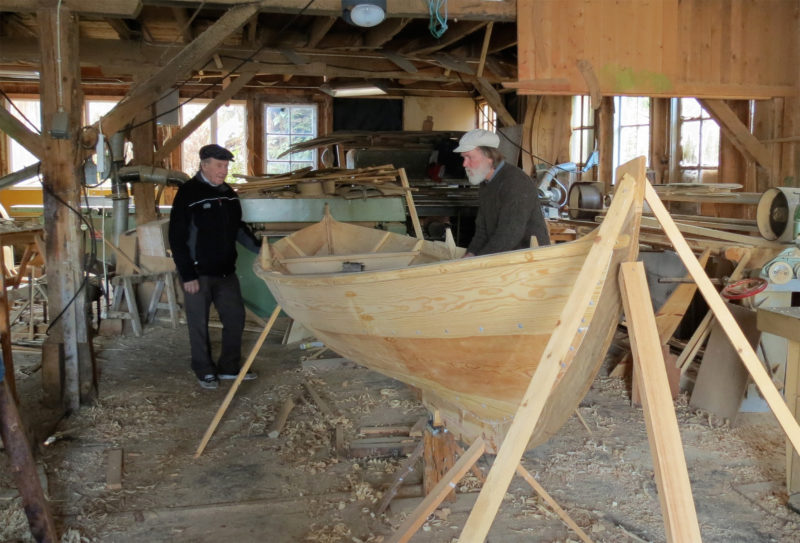
Nils Ulset and Jay review details on another of the many geitbåts built at Ulset Båtbyggeri.
At the start of my apprenticeship I helped fasten planking, cleaned up scrap and rippings at the bandsaw, swept floors, and, at the end of each day, dumped barrels of shavings into the fjord. After several months I was given a small work area, a bench with hand tools, and began taking direction from Nils directly in building small boats. We began with a 12′ pram (ferge) working the gains and lap bevels, and I got a good introduction to making sawn frames and riveting. We progressed quickly to a 15′ transom faering (tværskotting) with scarfs and hood ends to master. Another pram and a 15′ runabout with foredeck, mahogany-framed windshield and stern sheets took us into the summer. These were certainly valuable exercises in lapstrake construction, joinery, and the importance of a fair line, but none of these boats had the striking elegance of the older, wide-planked faerings in the boathouses (nausts) and small-boat museums.
By this time I had become comfortable enough in the local dialect to chat a bit—when appropriate—and I mentioned my curiosity about the local workboats common in the 19th century, and broached the idea of building one. Nils thought it a good challenge and arranged to borrow a fine, wide-planked 21′ double-ender, a true geitbåt built in 1902, and we began building the first replica. It would be christened DEN FØRSTEFØDTE—the firstborn.
The geitbåt has been the stock workboat in the district of Nordmøre for over 500 years. Its origins lie in the small faerings of the Vikings and though some evolution in plank lines has occurred, many of the structural elements remain the same after 1,200 years. The last of the builders of these traditional faerings was Ola “Saksa” Reitan, from Halsa, who received an award from the King of Norway in 1933 as one of Norway’s finest boatbuilders. When asked how many boats he had built he replied, “Ja, I built 10 boats a year and have been building for 60 years.”
Geitbåts ranged in size from 17′ to 30′ and were essential transportation for farmers and fishermen who lived along the fjords. The name, meaning “goat boat,” refers to their ability to climb a wave with the ease of a goat climbing atop a rocky precipice. Those who have sailed them will certainly attest to this.
 Leah Kefgen
Leah Kefgen In Jay’s shop in Anacortes, Washington, beginning the carved garboards for the geitbåt was a daunting task for the crew building the boat.
What makes this boat so exceptional isn’t the stem or the stern, the sheerline, or the freeboard. It is the keel and the garboards that harken back to a time before sawmills when keels and planks were riven from raw logs, and boats were essentially carved with axes, drawknives, smoothing planes, and sheath knives. These boats were built quickly, but with exacting dexterity. Each stroke of the axe had purpose; every pass of the plane was intentional. It was not unusual for two men to complete a 21′ geitbåt in two six-day work weeks.
The keel is taken from a 6″ × 10″ timber and carved to a T-shaped cross section, creating a shallow bilge and a narrow keel. The shape allows the garboards to be riveted to the keel, as opposed to being spiked into a rabbet. This eliminates the issues of the garboards leaking over time. This positive fastening of the garboards gives the boat a foundation for longevity where other construction methods often fail.
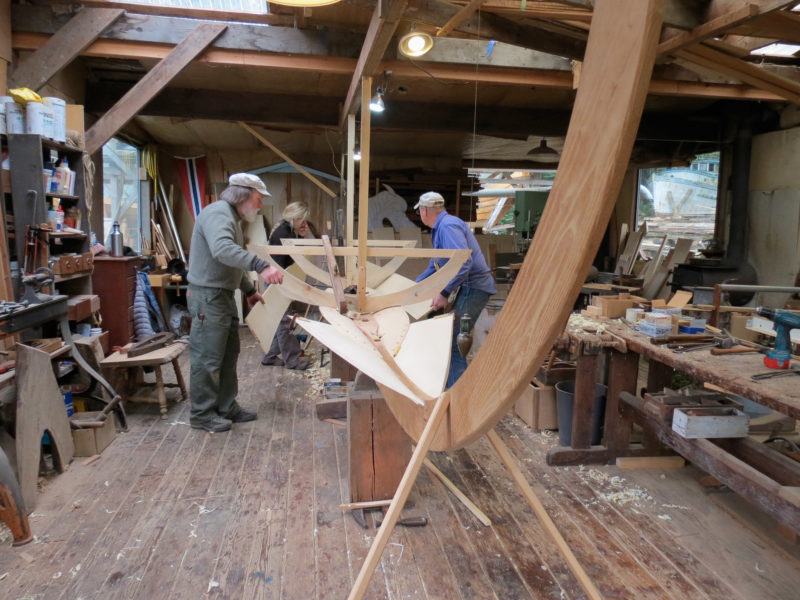 Susan Wood
Susan WoodJay, Leah, and Torolf carefully bend the broad strake’s aft planks into place as the geitbåt takes shape in Anacortes.
The garboards are made from short cants 2 1/2″ to 3″ thick, 16″ wide, and carved concave and with a bit of a twist, with a final thickness of around 1/2”. Each garboard is done in sections: one plank section forward, one aft, connected by the flat middle (midtstykke) plank. The forward ends of the broadstrake planks are also carved from cants, giving a concave entry and even more lift and stability in the bow. The carved planks not only give the boat its character and its stability, they also are quite sculptural. This carved, concave bottom, when viewed early on in construction, resembles the form of a bird in flight.
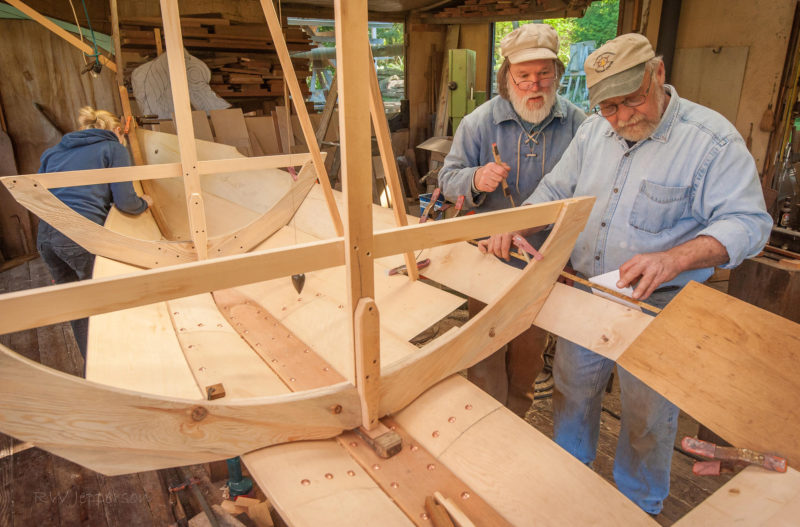 Bob Jepperson
Bob JeppersonWith Jay looking over his shoulder, Vern Lauridsen prepares a pattern for the third strake’s forward plank sections.
Every plank, every thwart, station, and “room” (the space between frames) in a geitbåt has a name, often with profound meaning. The wide forward planks at waterline, for example, are the fram kjempe or “those who do battle.” The garboard is the hals, meaning “throat.” Once the garboards and forward broad planks have been fastened, planking becomes rather straightforward.
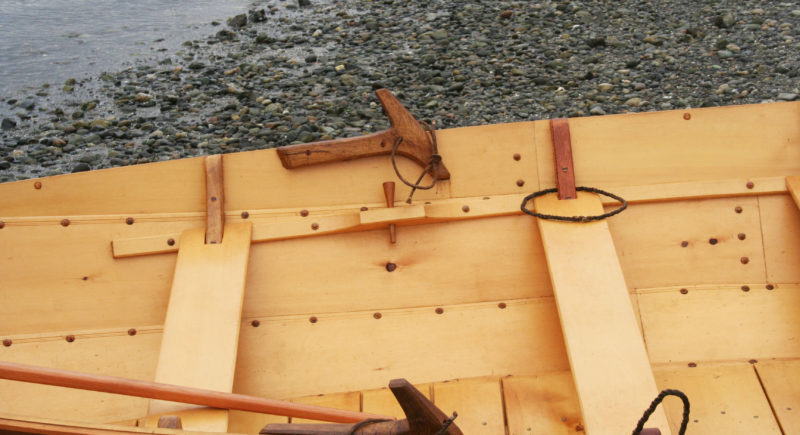 Christopher Cunningham
Christopher CunninghamThe natural grown oak oarlocks, treenail-fastened through the sheer plank, are witness to the boatbuilding traditions little changed since the Viking era.
Sawn floor timbers are fitted and installed at this stage; they’re fastened with trunnels (treenails) fastened with their button heads outboard and slots and wedges inboard. Trunnels are typically centered in the plank width and doubled in very wide planks. With garboards and broad planks in place and floor timbers fastened, the planking can continue. Planks are 16″ to 18″ in width, which allows a 20′ geitbåt to be planked with four strakes, with the sheerstrake tapering up to the sheerline and running out there, just forward of the aft stem.
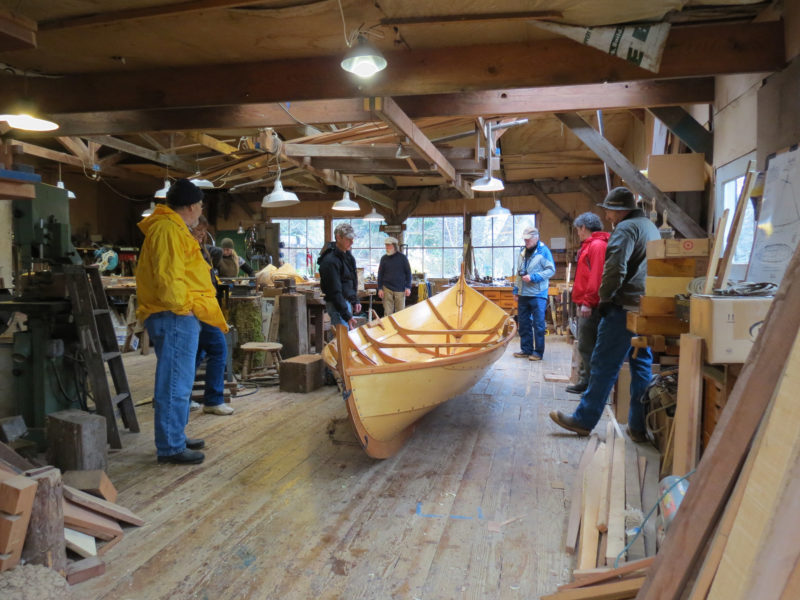 Susan Wood
Susan WoodAll hands are ready to assist as the new boat is taken off her blocks and freed from her overhead shoring beam.
The hull form is much like a codfish: full in its forward section, slender aft. The sheer rises to the bow and is a bit lower at the sternpost. The sternpost is laid back a bit whereas the stem rises nearly to plumb, but not beyond. The planking is completed when the sheer planks are fitted and fastened; they’re installed with plenty of extra width, allowing for the striking of the sheer with an axe, a momentous occasion that requires a keen eye and a refined sense for balance and symmetry.
All of the interior framing is of grown crooks with minimal scantlings and trunnel fastenings. The end-most frames, shaped like wishbones, are canted inward. Thwarts are fitted on crossbeams and held in place by the upper frames, but are not fastened, which allows for freedom of movement and comfort when rowing long distances for extended periods of time. The traditional oarlock (kjæppa) is taken from the trunk and a branch of a birch tree, with the trunk section fastened along the sheer; the oar rests in the crotch of the branch. This part of the tree is inherently strong and durable. A 9″-diameter grommet, made of withe from a willow or birch sapling, is reeved through the oarlock to keep the oar on the return stroke. Withes are extremely tough and readily available. (Our English word, withe, comes from Old Norse vi ð r, meaning willow). The gudgeons and pintles are an ingeniously simple work of Norse wizardry, as is the steering system with its athwartships rudder arm and infinitely versatile push-pull tiller.
The geitbåt carries a single mast with a large, asymmetrical mainsail that functions as a main and a jib together. A sheet, a tack up forward along the rail, a halyard and vang from the yard aloft, and a series of reefpoints make for a simple, efficient sailing rig.
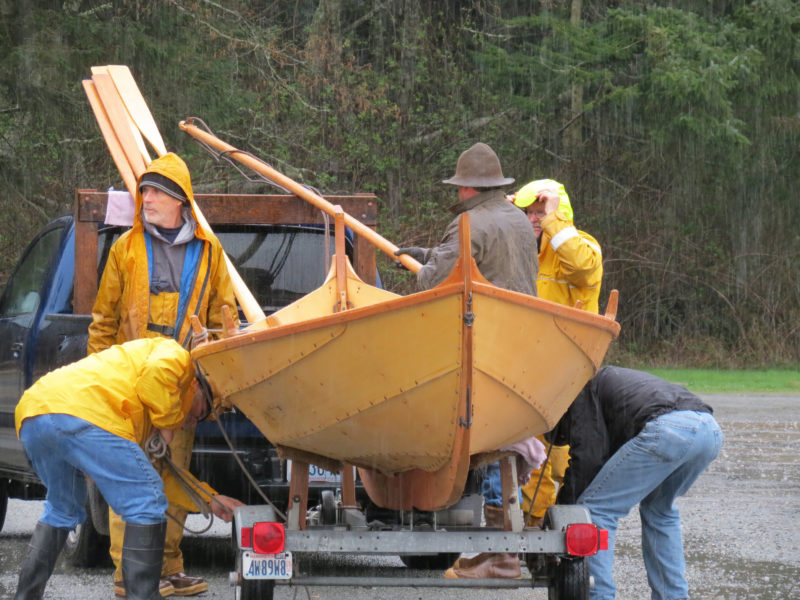 Susan Wood
Susan WoodOn launch day the Anacortes Friday Guild and compatriots raised the TJÆLD off the trailer and carried her to the Puget Sound shoreline. Note the aft ends of the sheer planks ending at the sheer, a few feet forward of the sternpost.
To build a replica of a classic wooden boat under the direction of a highly accomplished master builder is a truly exhilarating experience. A true master of the trade is able to visualize at once the three-dimensional, T-shaped keel or the hollowed and twisted garboard plank, commit it to memory, and reproduce the piece at his bench with extraordinary ease and accuracy. The apprentice should not expect a verbal analysis of the work but must learn through observation and practice. The reward for good work may be as inconsequential as a simple nod or a smile; inferior work is merely set aside for some other use and a second attempt is begun. At the close of each work day, stepping back to eye the fluid lines, the dynamic physical form, and the minimal scantlings—all so neatly seated in a bed of shavings and woodchips—the boatbuilders would scarcely gave a thought to the day’s wages as part of the equation.
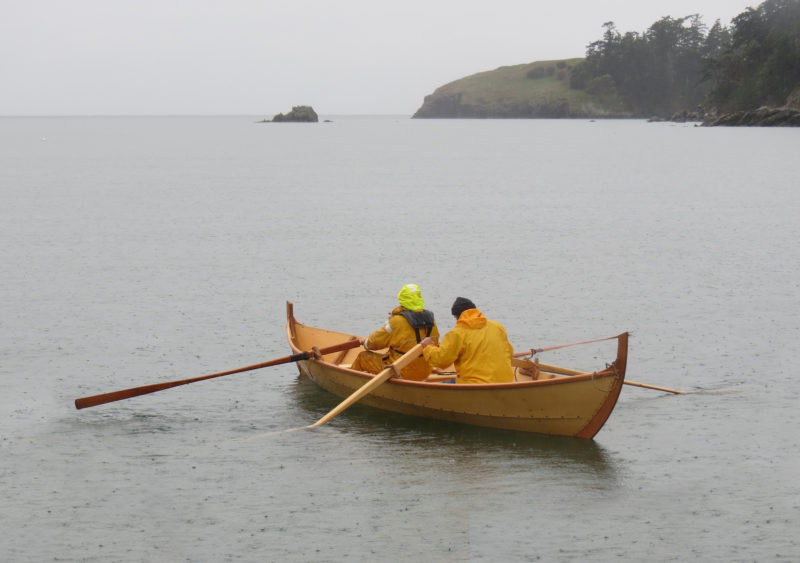 Susan Wood
Susan Wood On launch day, the TJÆLD was christened by rowing in a circle three times with the sun, an old Norse ritual.
Within days of blocking and plumbing the backbone, we fastened floor timbers and upper frames, installed trunnels. We notched and beveled the thwarts and dropped them into place, each capturing a frame head port and starboard. Rubrails and oarlocks, rudder and tiller all came in rapid succession and early one Thursday afternoon we threw open the double doors to the north and launched DEN FØRSTEFØDTE.
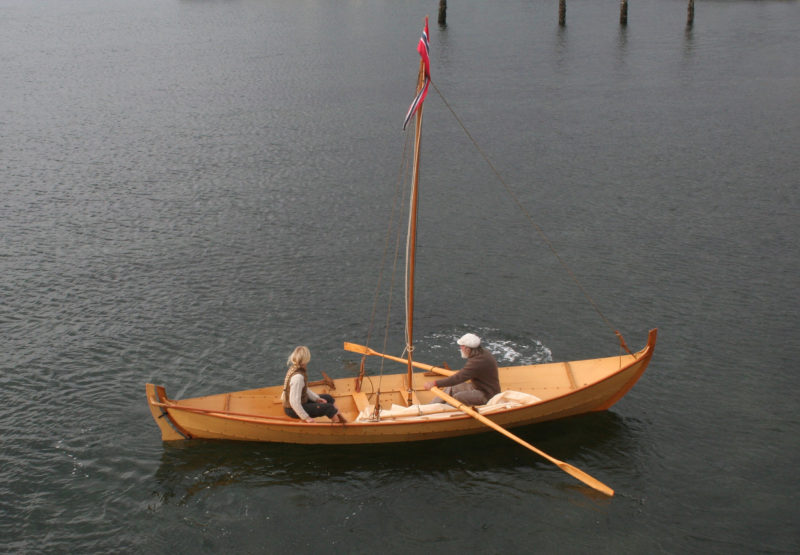 Christopher Cunningham
Christopher CunninghamLeah and Jay take the TJÆLD for an early morning rowing tour at the Wooden Boat Festival in Port Townsend, WA.
After my extended period of living abroad, my homecoming to America, was a thrilling, joyous occasion, but also left me with sadness over the loss and separation. Seventeen years passed before Nils and I, once master and apprentice, would again plank a geitbåt together. I had returned to the States, settled in Anacortes, raised a family, built faerings, planked fishing boats, repaired classic yachts, and redesigned yacht interiors.
In Norway, Nils carried on the tradition of lapstrake boats of the fjords of western Norway. Ulset Båtbyggeri became a one-man shop again as it had been in the ’60s and ’70s, with Nils as the boatbuilder. Nils never stopped building, even in retirement. For another 23 years repairs came steadily into the shop, along with commissions for new geitbåts. He was asked: “So Nils, how many geitbåts have you built over the last 20 years?” “Oh, I’d have to say three geitbåts a year, maybe four, and a handful of repairs, you know.” He gained a reputation as the builder of historic replicas, and literally carved out a second career for himself. He built his last boat in 2014 at the age of 89, always bright, cheerful, and up to the task with a bandsaw, a planer, and nine simple hand tools.
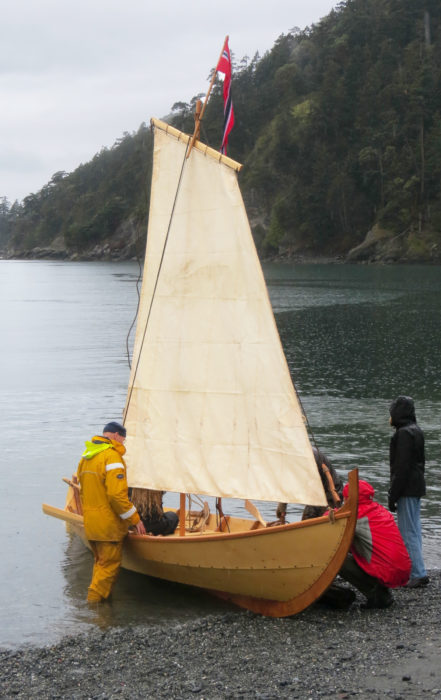 Susan Wood
Susan WoodTJÆLD is prepared for sea trials on a blustery Northwest winter’s day.
On each of my return trips to Norway, Nils would ask, “Have you built a geitbåt in America, now?” and I would promise that I would soon. For many years I had been setting aside “geitbåt planks,” grown crooks, and the finest locust, oak, and Alaska yellow cedar, hoping someday to take the time to build a geitbåt on my own, but it was a group of close friends who take the credit for making it happen. On Fridays at my shop I welcome volunteers, usually three or four locals, and they eventually came to be known as The Friday Guild. After completing several small lapstrake projects together, they agreed to attempt a 20′ geitbåt with carved garboards, natural crooks and trunnel fastenings—quite a challenge for a handful of apprentices. Fridays quickly became the high point of the week with everyone poring over the next plank scarf or inserting more rivets and roves. I took the role of teacher, allowing them to accomplish the task themselves. We emphasized trusting our eyes and hands, believing that if it looks right, it is good. Plumb bobs and spokeshaves were always at hand. After many months of Fridays, the last of the planking was fastened and the guild had only the rudder, spars, and oars left to make.
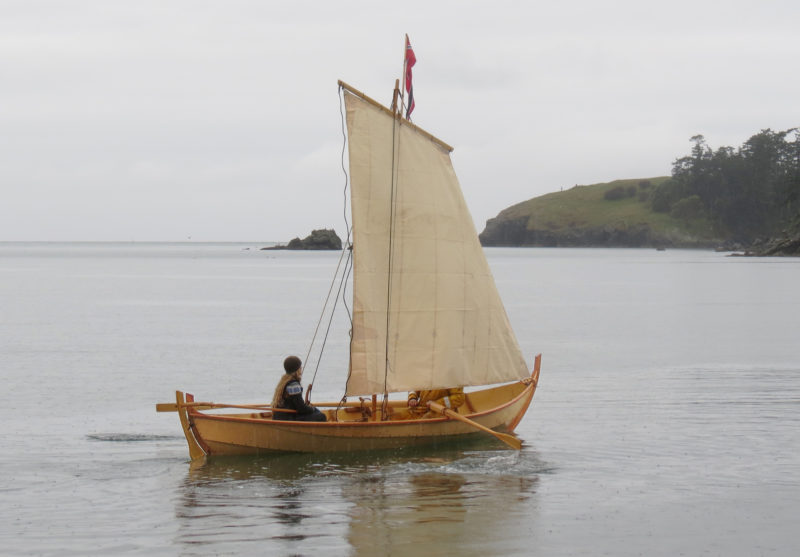 Susan Wood
Susan WoodLeah is at the helm for TJÆLD’s maiden voyage at Bowman Bay on Fidalgo Island.
On a blustery winter’s day in 2014, the Friday Guild, with family and friends gathered on the beach for the launching (sjøsetting) of TJÆLD (Oystercatcher), the first geitbåt on Puget Sound. I mailed photos to Nils proving that I did finally build a geitbåt in the USA. And what did Nils say? His response was a simple, “Ikkje så værst, gutt.” Not so bad, my boy.![]()
Jay Smith does business as Aspøya Boats in Anacortes, Washington. He now has a 38′ Viking ship replica is now under way at and the Friday Guild is assembling the backbone for a new 18′ Nordfjord færing.
If you have an interesting story to tell about your adventures with a small wooden boat, please email us a brief outline and a few photos.
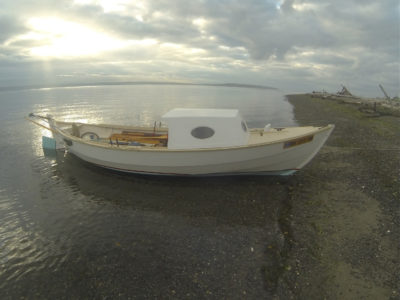

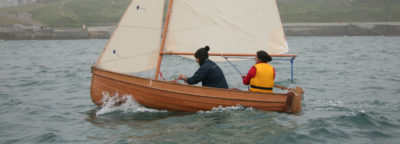
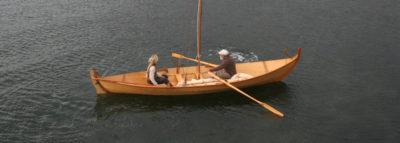
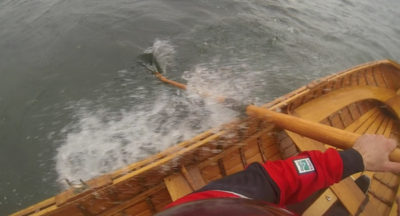
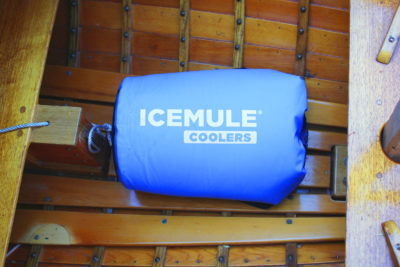
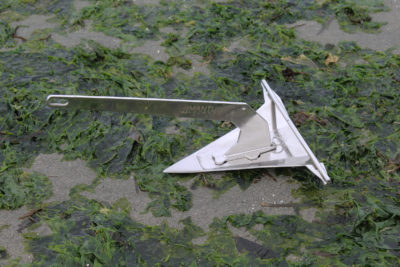
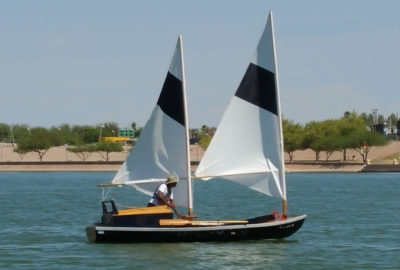
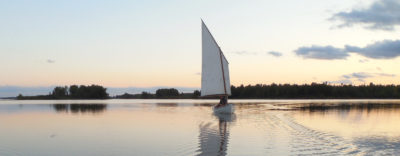
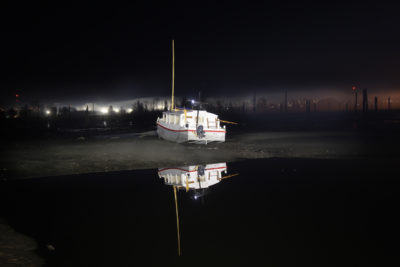
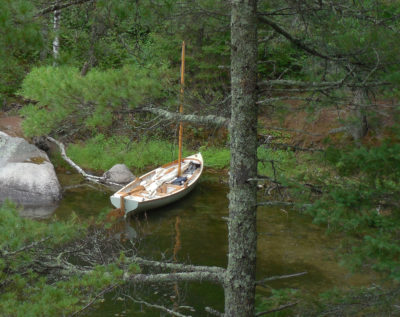
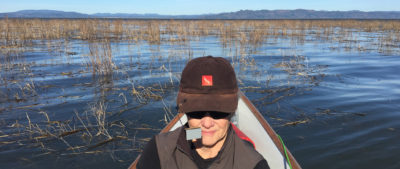
Saw a video of this boat on Off Center Harbor, and was excited to read this in-depth article. The lines, craftsmanship, and simplicity are inspiring.
A dipping lug rig, it appears. Never tried one, but Phil Bolger regards the rig as a very powerful one.
An amazing story of craftsmanship and passion.
Both are a basic requirement in my mind to
build such beautiful boats. Thanks.
Oh to have such skill as to be able to take a hatchet and cut the sweet curve of the sheer. I am forever amazed at the skill and eye for beauty of my Norwegian ancestors. Wonderful article.
Beautiful boat, and a well written article. My set of skills will only allow me to produce pale plywood approximations, but I do really appreciate the real thing. Your boat stirs the soul, and connects to history and the Earth itself. Congratulations.
Fascinating article! I am interested in your comments on the direction of the grain on the keel timber relative to the T-shape. Looking at the end of a log, where on the face of the log is the best place to take the 6”x10” timber from? Of course the diameter of the log is going to make a difference. Are there considerations to prevent the keel from breaking from the lateral force of water resistance when under sail?
Is that a dipping lug? Looks like a square sail tacked up to go to windward.
What a wonderful and inspiring story, Jay! My dreams were of a similar path in the ’70s. I went so far as to get an application from the school in Saltdal [Norway]. In the end, though, other obligations kept me from attending. At the time I did build a copy of a Faeroese Four-Man Boat, based on one built by Niklas Koltri, of Torshavn, who’s boat is at the Norse Heritage Museum in Ballard. Paul Schweiss, formerly of Tacoma, kindly supplied me with measurements, patterns and photos. Currently I’m reading “Nordladsbåten og Åfjordsbåten”–dictionary in hand–by Gunnar Eldjarn and Jon Godal. By the time I finish I figure I’ll at least be able to read Norwegian, though speaking and understanding may be a bit sketchy, then I’ll attempt to build a Nordlands Faering.
A question for you please: would you describe the process of carving the garboards? I’ve seen some photos, some using axe, others by hollowing by using a saw, as in your picture, but how do you figure out the twist, necessary for the plank to fasten to the stem? Does it come from the natural twist in the log, or can it be developed from a thicker plank? I’m so in the dark about this I’m not sure I’m even asking the right questions. Thank you again for a great story.